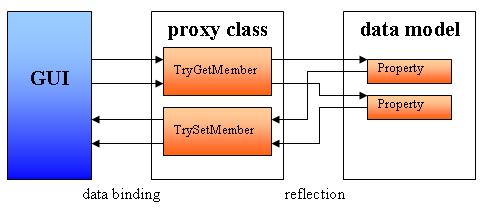Avoid calling RaisePropertyChanged in every setter
I want to get rid of the space consuming and repetitive RaisePropertyChanged-Properties on my model classes. I want my model class...
public class ProductWorkItem : NotificationObject
{
private string name;
public string Name
{
get { return name; }
set {
if (value == name) return;
name = value; RaisePropertyChanged(() => Name);
}
}
private string description;
public string Description
{
get { return description; }
set {
if (value == description) return;
description = value; RaisePropertyChanged(() => Description);
}
}
private string brand;
public string Brand
{
get { return brand; }
set {
if (value == brand) return;
brand = value; RaisePropertyChanged(() => Brand);
}
}
}
...to look as simple as this again: (but notify the view when a property changes)
public class ProductWorkItem
{
public string Name{ get; set; }
public string Description{ get; set; }
public string Brand{ get; set; }
}
Could this be achieved with some sort of proxy class?
I want to avoid writing a proxy for every single model class.
I found this class in the System.Dynamic namespace... It lets you intercept the actual DataBinding calls made by the DependencyObject on your binding target, to the Property on your binding source.
So what one could do now is to implement a class (lets call it DynamicNpcProxy) that implements INotifyPropertyChanged, is derived from DynamicObject and overrides both the TryGetMember and TrySetMember methods.
public class DynamicNpcProxy : DynamicObject, INotifyPropertyChanged
{
public DynamicNpcProxy(object proxiedObject)
{
ProxiedObject = proxiedObject;
}
//...
public object ProxiedObject { get; set; }
public override bool TrySetMember(SetMemberBinder binder, object value)
{
SetMember(binder.Name, value);
return true;
}
protected virtual void SetMember(string propertyName, object value)
{
GetPropertyInfo(propertyName).SetValue(ProxiedObject, value, null);
if (PropertyChanged != null)
PropertyChanged(ProxiedObject, new PropertyChangedEventArgs(propertyName));
}
protected PropertyInfo GetPropertyInfo(string propertyName)
{
return ProxiedObject.GetType().GetProperty(propertyName);
}
// override bool TryGetMember(...)
}
To get it to work, wrap the proxy around your current binding source, replace them and let DynamicObject do the rest.
In ViewModel.cs:
IList<ProductWorkItem> items;
//... assign items
var proxies = items.Select(p => new DynamicNpcProxy(p)).ToList();
ICollectionView Products = CollectionViewSource.GetDefaultView(proxies);
In View.xaml:
<TextBox Text="{Binding Products.CurrentItem.Name}" />
<TextBox Text="{Binding Products.CurrentItem.Description}" />
What you end up with is this:

Also check out this article over at the code project which provides even more information...
- Sort program not working, not sure why
- Fast & accurate atan/arctan approximation algorithm
- What's the difference between strtok_r and strtok_s in C?
- How memory address for pointer to arrays is same as an element in 2D array?
- Which is the best way to suppress "unused variable" warning
- How to use ellipsis in c's case statement?
- How can I exclude non-numeric keys? CS50 Caesar Pset2
- Fast ceiling of an integer division in C / C++
- Is there an invalid pthread_t id?
- How to Implement Universal Setter/Getter Functions for Interrupt-Driven Variables in Embedded C?
- How does SIMD (avx) processing work? for example, if I want 10 32 bit floats how do i fit in a 256 bit avx vector?
- FDCAN problems on STM32G4
- How does the call macro enable mutual recursion between functions f and g in this Hanoi Tower implementation?
- Running test on Rocket core CPU - global variable initialized to 0 is unsuccessful, output wrong value instead
- Interacting with C arrays without knowing the size
- Combination of two strings
- Avoiding strcpy overflow destination warning
- carriage return by fgets
- How to use special characters in C?
- Why does 1.0/100.0 == 0.1/10.0 give True?
- Is it correct to compare pointers in C?
- Force free() to return malloc memory back to OS
- How can I print to standard error in C with 'printf'?
- What is the standard behavior of fread in C on Windows?
- How is strtok removing lines it shouldn't have access to?
- Using array as smart point in C
- Assigning string to malloced 2d char array not working as intended
- How to refactor repetition inside a Makefile?
- Why does an empty preprocessor command still evaluate to something?
- How to implement variable sized array within C struct